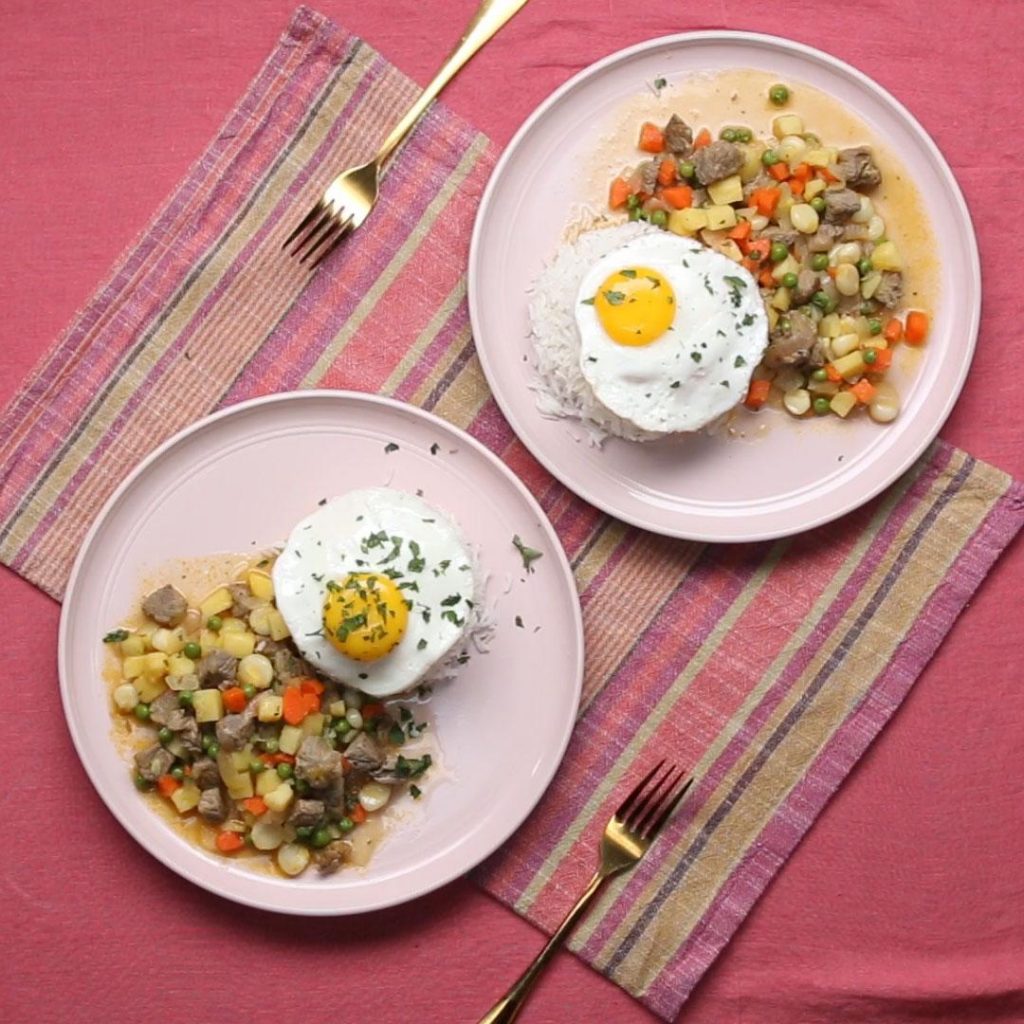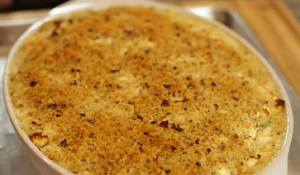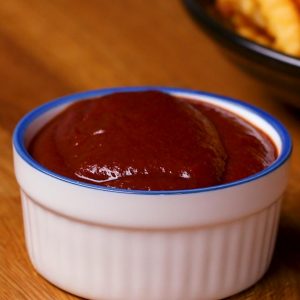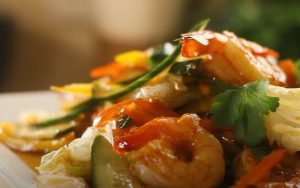Picante de Carne is a savory Peruvian dish that combines sirloin steak with a variety of vegetables, and is seasoned with an array of authentic spices. It's a hearty meal that is sure to satisfy everyone at your table, and it's a great way to introduce your family to the rich flavors of Peruvian cuisine.

Photos of Picante De Carne (Steak With Veggies) Recipe
The key ingredient that sets this dish apart is the aji amarillo paste, a Peruvian yellow pepper paste. It's moderately spicy but adds a unique flavor that can't be replicated with other spices. This paste might be harder to find in a regular supermarket, but it can be found easily in any Latin American grocery store or online. In addition, Peruvian corn, also known as choclo, is another authentic ingredient used in this recipe, which is larger and starchier than the sweet corn found in most supermarkets.
Ingredients for Picante de Carne: Steak with Veggies
Sirloin steak: This is the main protein in the dish, providing a robust and meaty flavor.
Salt and pepper: Basic seasonings used to enhance the natural flavor of the steak.
Cumin seeds: They add a warm and earthy flavor.
Canola oil: Used for sautéing the ingredients.
Yellow onion: Adds a sweet, caramel-like flavor when sautéed.
Garlic: Provides a strong, pungent flavor.
Aji amarillo paste: A Peruvian yellow pepper paste that gives the dish its characteristic spicy kick.
Golden potato: Adds starch and substance to the stew.
Carrot: Adds sweetness and color.
Water and chicken bouillon powder: The base of the stew, providing flavor and moisture.
Green peas: Adds a fresh and slightly sweet flavor.
Peruvian corn: A starchy variety of corn native to Peru.
Peruvian-style rice, egg, and fresh parsley: Used for serving and garnishing the dish.
One reader, Dominga Mcmillen says:





This picante de carne recipe is a game-changer! The flavors are so rich and the steak is perfectly tender. The combination of veggies adds a delightful crunch. It's a must-try for anyone who loves a hearty, flavorful meal. I can't wait to make it again!
Techniques Required
Season the steak: Rub the steak with salt, pepper, and cumin to evenly coat the meat and enhance its flavor.
Sauté the onion and garlic: Cook the onion and garlic in oil until they are translucent and fragrant, adding depth of flavor to the dish.
Simmer the stew: Allow the stew to simmer, covered, until the potatoes, carrots, peas, and corn are cooked through, ensuring that all the vegetables are tender and flavorful.
Serve the dish: Present the picante de carne with rice and a sunny-side up egg, and garnish with chopped parsley for a delightful finishing touch.
How To Make Picante De Carne (Steak With Veggies)
Made with juicy sirloin steak, veggies, and a tasty mixture of sauce and seasonings, this delicious Peruvian Picante de Carne will surely steal your heart.
Serves:
Ingredients
- 1lbsirloin steak,cut into cubes
- salt and pepper,to taste
- 1tspcumin seeds
- 1tbspcanola oil,divided
- 2cupsyellow onion
- 2tspgarlic,pureed
- 1tbspaji amarillo paste
- 2cupsgolden potato,diced
- 1cupcarrot,diced
- 2cupswater
- 1tspchicken bouillon Powder
- 1cupgreen peas
- 1cupfresh Peruvian corn,(choclo) or frozen
For Serving:
- peruvian-style rice,or other cooked white rice
- egg,cooked, sunny-side up
- fresh parsley,chopped
Instructions
-
Season the steak with salt, pepper, and cumin.
-
Heat 1 tablespoon of canola oil on a medium pot over medium-high heat. Add the steak and cook for about 5 to 6 minutes until browned.
-
Remove the steak from the pot and set aside.
-
Add the remaining tablespoon of oil to the pot, then add the onion and sauté for about 5 to 6 minutes until translucent.
-
Add the garlic and ají amarillo, and sauté for 3 minutes until fragrant.
-
Return the steak to the pot, then add the water and bouillon. Mix to dissolve the bouillon powder.
-
Add the potatoes and carrots. Bring the stew to a simmer, cover, and cook for 10 minutes, or until the potato and carrot are cooked through.
-
Add the peas and Peruvian corn. Cook for another 5 minutes, or until the peas and corn are cooked through.
-
Serve the Picante de Carne with rice and sunny-side up eggs. Sprinkle chopped parsley on top.
-
Enjoy!
Nutrition
- Calories: 446.97kcal
- Fat: 20.78g
- Saturated Fat: 7.04g
- Trans Fat: 0.02g
- Monounsaturated Fat: 9.44g
- Polyunsaturated Fat: 1.98g
- Carbohydrates: 37.59g
- Fiber: 7.06g
- Sugar: 9.82g
- Protein: 28.98g
- Cholesterol: 88.52mg
- Sodium: 1168.02mg
- Calcium: 101.55mg
- Potassium: 1131.18mg
- Iron: 4.06mg
- Vitamin A: 293.32µg
- Vitamin C: 46.54mg
Technique Tip for Picante de Carne
When preparing the steak, it's important to let it rest after browning and before adding it back into the pot. This allows the juices to redistribute throughout the meat, resulting in a more tender and flavorful dish. Additionally, using cumin seeds instead of ground cumin can provide a more robust flavor. Toast the seeds lightly before grinding them to release their aromatic oils.
Time-Saving Tips for Preparing This Steak with Veggies Recipe
Prep ahead: Chop vegetables and marinate the steak the night before to save time on the day of cooking.
One-pot wonder: Use a single pot for cooking the entire dish to minimize cleanup and save time.
Multitask: While the stew is simmering, prepare the rice and eggs to make the most of your time in the kitchen.
Frozen veggies: Consider using frozen peas and corn to save time on chopping and prepping fresh vegetables.
Efficient chopping: Cut the vegetables into uniform pieces to ensure even cooking and save time during preparation.
Quick release: Use a pressure cooker to expedite the cooking process and save time while still achieving flavorful results.
Substitute Ingredients For Picante De Carne (Steak With Veggies) Recipe
sirloin steak - Substitute with flank steak: Flank steak is a lean and flavorful cut that can be used as a substitute for sirloin steak in this recipe. It has a similar texture and can be cooked to the desired level of doneness.
canola oil - Substitute with vegetable oil: Vegetable oil can be used as a substitute for canola oil in this recipe as it has a neutral flavor and a similar smoke point, making it suitable for sautéing and frying.
yellow onion - Substitute with white onion: White onions can be used as a substitute for yellow onions in this recipe, providing a slightly sharper flavor that complements the other ingredients well.
garlic - Substitute with garlic powder: Garlic powder can be used as a substitute for fresh garlic in this recipe. It adds a concentrated garlic flavor and can be added directly to the dish during cooking.
aji amarillo paste - Substitute with habanero paste: Habanero paste can be used as a substitute for aji amarillo paste, providing a similar level of heat and a fruity, citrusy flavor to the dish.
golden potato - Substitute with Yukon Gold potato: Yukon Gold potatoes can be used as a substitute for golden potatoes, as they have a similar waxy texture and buttery flavor that works well in this recipe.
carrot - Substitute with parsnip: Parsnips can be used as a substitute for carrots, adding a slightly sweeter and nuttier flavor to the dish.
chicken bouillon powder - Substitute with vegetable bouillon powder: Vegetable bouillon powder can be used as a substitute for chicken bouillon powder, adding savory flavor to the dish while keeping it vegetarian-friendly.
green peas - Substitute with edamame: Edamame can be used as a substitute for green peas, providing a similar pop of color and texture to the dish.
fresh Peruvian corn - Substitute with frozen corn kernels: Frozen corn kernels can be used as a substitute for fresh Peruvian corn, providing a convenient option while still adding sweetness and crunch to the dish.
Peruvian-style rice - Substitute with jasmine rice: Jasmine rice can be used as a substitute for Peruvian-style rice, offering a fragrant and slightly sticky texture that complements the dish.
egg - Substitute with tofu scramble: Tofu scramble can be used as a substitute for eggs, providing a plant-based alternative that adds protein and a creamy texture to the dish.
fresh parsley - Substitute with cilantro: Cilantro can be used as a substitute for fresh parsley, adding a bright and citrusy flavor to the dish.
Plating Ideas for Picante de Carne
Elevate the plating: When presenting the picante de carne, pay attention to the arrangement of the components on the plate. Create a visually appealing presentation by layering the steak and vegetables in an artful manner, using colorful and vibrant ingredients to enhance the overall look.
Incorporate texture: Introduce a variety of textures to the dish. Consider adding a crispy element, such as a delicate potato crisp or a garnish of toasted quinoa, to provide contrast to the tender steak and vegetables.
Focus on precision: Pay attention to the placement of each element on the plate. Use precise techniques to ensure that the dish is presented with finesse, showcasing the skill and attention to detail that goes into its preparation.
Highlight the vibrant colors: Emphasize the natural colors of the ingredients to create a visually stunning presentation. Incorporate bright hues from the aji amarillo paste, golden potatoes, and fresh Peruvian corn to add visual interest to the dish.
Incorporate fresh herbs: Introduce a touch of freshness by garnishing the dish with fragrant cilantro or chives. The addition of fresh herbs not only enhances the visual appeal but also contributes to the overall flavor profile.
Utilize elegant serving ware: Select elegant and sophisticated serving ware to complement the upscale presentation of the picante de carne. Choose plates and bowls that enhance the visual appeal of the dish and elevate the dining experience for the judges.
Emphasize balance and harmony: Strive for a balanced composition on the plate, ensuring that each element harmonizes with the others. Pay attention to the distribution of colors, shapes, and textures to create a visually striking and harmonious presentation.
Consider the negative space: Embrace the concept of negative space on the plate to create a visually striking presentation. Allow the dish to breathe by strategically arranging the components, ensuring that the plate appears visually balanced and inviting.
Add a finishing touch: Before presenting the dish, add a final touch that elevates the overall presentation. This could be a drizzle of chimichurri sauce, a sprinkle of smoked paprika, or a delicate dusting of edible flower petals to add a touch of sophistication.
Craft an enticing frame: Pay attention to the edges of the plate, ensuring that they are clean and free of any spills or smudges. The presentation should be framed elegantly, drawing the judges' attention to the meticulously arranged components of the picante de carne.
Essential Kitchen Tools for Making Picante de Carne
- Cutting board: A flat, sturdy surface used for cutting, chopping, and preparing ingredients.
- Chef's knife: A versatile, all-purpose knife used for slicing, dicing, and chopping ingredients.
- Skillet: A flat-bottomed pan with sloping sides, used for frying, sautéing, and searing ingredients.
- Tongs: A kitchen tool with two arms and a pivot, used for gripping and lifting hot or delicate foods.
- Wooden spoon: A cooking utensil with a long handle, used for stirring, mixing, and tasting dishes.
- Measuring cups and spoons: Tools used for accurately measuring ingredients in cooking and baking.
- Grill: A cooking surface with heat source below, used for grilling and searing meats and vegetables.
- Blender: A kitchen appliance used for blending, pureeing, and emulsifying ingredients into smooth mixtures.
- Colander: A bowl-shaped kitchen utensil with perforations, used for draining liquids from foods.
- Saucepan: A deep cooking pot with a long handle and a lid, used for boiling, simmering, and making sauces.
- Whisk: A kitchen tool with a handle and wire loops, used for whipping, beating, and incorporating air into ingredients.
- Baking sheet: A flat, rectangular metal pan used for baking, roasting, and toasting foods in the oven.
- Pastry brush: A cooking utensil with bristles, used for brushing sauces, glazes, and oils onto food.
- Meat thermometer: A tool used to measure the internal temperature of cooked meats to ensure they are safe to eat.
- Mortar and pestle: A pair of tools used for grinding and crushing spices, herbs, and other ingredients.
- Spatula: A flat, flexible kitchen tool used for flipping, lifting, and spreading ingredients while cooking.
How To Store / Freeze Picante de Carne
- Allow the picante de carne to cool completely before storing or freezing.
- Transfer the cooled stew to an airtight container or a heavy-duty freezer bag.
- If using a container, make sure to leave about an inch of headspace at the top to allow for expansion during freezing.
- Label the container or bag with the date and contents.
- Store the picante de carne in the refrigerator for up to 3-4 days.
- To freeze, place the container or bag in the freezer and store for up to 2-3 months.
- When ready to eat, thaw the frozen picante de carne in the refrigerator overnight.
- Reheat the thawed stew in a pot over medium heat, stirring occasionally, until heated through.
- If the stew seems too thick after thawing, add a little water or broth to thin it out.
- Taste and adjust the seasoning if needed before serving.
- For best results, store the rice and eggs separately and prepare them fresh when ready to serve the reheated picante de carne.
How To Reheat Leftovers
- The best way to reheat leftover picante de carne is to use a microwave or a stovetop. If using a microwave, place the desired portion in a microwave-safe dish, cover it with a damp paper towel, and heat it on high for 1-2 minutes or until heated through. Stir the dish halfway through to ensure even heating.
- If using a stovetop, place the leftover picante de carne in a saucepan over medium heat. Add a splash of water or chicken broth to the pan to prevent the dish from drying out. Stir occasionally and heat until the steak and vegetables are warmed through, about 5-7 minutes.
- To maintain the texture and flavor of the steak, avoid reheating it for too long or at too high a temperature. Overheating can cause the meat to become tough and dry.
- If you have leftover rice, reheat it separately in the microwave or on the stovetop. Add a tablespoon of water to the rice and cover it with a damp paper towel before microwaving to help restore moisture.
- For a crispy texture on the reheated potatoes and carrots, you can briefly sauté them in a pan with a small amount of oil over medium-high heat before adding the reheated steak and other vegetables.
- If you prefer a fresh egg on top of your reheated picante de carne, fry a new sunny-side up egg just before serving.
- Garnish the reheated dish with freshly chopped parsley to brighten up the flavors and add a pop of color.
Random Fact About Picante de Carne
The dish Picante de Carne is a traditional Peruvian stew that is known for its rich and flavorful taste. It is a popular comfort food in Peru and is often enjoyed during family gatherings and special occasions. The combination of tender steak, aromatic spices, and a variety of vegetables creates a hearty and satisfying meal that is loved by many. This dish is a perfect representation of the diverse and vibrant culinary culture of Peru, showcasing the use of indigenous ingredients such as aji amarillo and Peruvian corn.
Is This Steak with Veggies Recipe Budget-Friendly?
This picante de carne recipe is quite cost-effective for a household. The combination of sirloin steak, potatoes, carrots, and green peas offers a hearty and satisfying meal. The use of affordable ingredients and simple cooking methods makes it budget-friendly. The approximate cost for a household of 4 people is around $20-$25, making it an economical choice. The overall verdict rating for this recipe would be 8 out of 10 for its affordability and delicious outcome.
Is This Steak and Veggie Recipe Healthy?
The picante de carne recipe is a relatively healthy dish, as it includes a variety of nutritious ingredients such as lean sirloin steak, vegetables (onion, garlic, potato, carrot, peas, and corn), and minimal added fat. The use of ají amarillo paste adds a unique Peruvian flavor and a slight kick of heat. However, there are a few aspects that could be improved to make the dish even healthier.
- Reduce the amount of added salt and rely more on the natural flavors of the ingredients and spices like cumin and ají amarillo paste.
- Use a low-sodium chicken bouillon powder or replace it with low-sodium chicken broth to reduce the overall sodium content.
- Include a larger variety of vegetables to increase the fiber, vitamin, and mineral content of the dish. Consider adding bell peppers, zucchini, or squash.
- Opt for brown rice instead of white rice as a serving option to increase the fiber content and provide a slower release of energy.
- Use a healthier cooking oil like olive oil instead of canola oil, which has a better fatty acid profile.
- Serve the dish with a side salad to add more fresh vegetables and balance out the meal.
- Consider using a leaner cut of beef, such as top round or tenderloin, to reduce the overall fat content of the dish.
Editor's Thoughts on This Steak and Veggie Dish
The picante de carne recipe is a delightful combination of flavors and textures. The use of sirloin steak, cumin, and aji amarillo paste creates a rich and aromatic base, while the addition of potatoes, carrots, peas, and Peruvian corn adds a hearty and satisfying element. The dish is beautifully balanced and offers a wonderful blend of savory and slightly spicy notes. Serving it with Peruvian-style rice and a sunny-side up egg adds a comforting touch. Overall, this recipe is a fantastic representation of traditional Peruvian cuisine and is sure to impress anyone who tries it.
Enhance Your Picante De Carne (Steak With Veggies) Recipe with These Unique Side Dishes:
Similar Recipes to Picante de Carne
Appetizer and Dessert Pairings for This Steak with Veggies Recipe
Why trust this Picante De Carne (Steak With Veggies) Recipe:
This recipe offers a tantalizing blend of flavors and textures, ensuring a delightful dining experience. The succulent sirloin steak is expertly seasoned with cumin seeds and cooked to perfection, while the addition of aji amarillo paste infuses a delightful kick. The medley of golden potatoes, carrots, green peas, and Peruvian corn creates a vibrant and wholesome dish. With the careful balance of ingredients and precise cooking instructions, this recipe guarantees a mouthwatering outcome. Trust in the expertise behind this recipe for a truly satisfying meal.
Was this page helpful?
Have your own special recipe to share? Submit Your Recipe Today!


-300x163.png)








